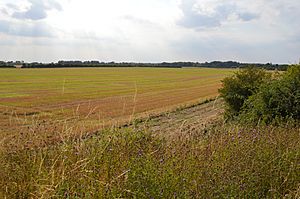Whittlesford - Thriplow Hummocky Fields facts for kids
| Site of Special Scientific Interest | |
 |
|
| Area of Search | Cambridgeshire |
|---|---|
| Interest | Biological |
| Area | 55.6 hectares |
| Notification | 1987 |
| Location map | Magic Map |
Whittlesford - Thriplow Hummocky Fields is a special natural area in Cambridgeshire, England. It covers about 55.6 hectares, which is like 137 football fields! This place is called a Site of Special Scientific Interest (SSSI) because it's home to some very rare plants and animals.
This unique area has shallow dips in its fields. These dips were formed thousands of years ago when the last ice age ended. Giant chunks of ice, called ice lenses, melted and left behind these hollows. These special spots are perfect for rare species like the grass-poly plant and the amazing fairy shrimp.
Contents
Discovering Whittlesford - Thriplow Hummocky Fields
This special site is made up of two fields. One is near Whittlesford and the other is close to Thriplow. Together, they form a large area of 55.6 hectares.
How the Hummocks Formed
The landscape here was shaped by the last ice age. When the ice melted, it left behind unique dips and bumps in the ground. These dips are called "hummocks." They were created by "ice lenses," which are like big pockets of ice that formed in the soil. When these ice lenses melted, they caused the ground to sink.
These special dips are very important. They collect water and create a unique wet habitat. This habitat is perfect for some very rare and interesting species.
Unique Plants of the Hummocks
One of the most special plants found here is the grass-poly. This plant is super rare in Great Britain. In fact, it's mostly found only in south Cambridgeshire!
Other interesting plants that grow in these wet dips include toad rush, greater plantain, and knotgrass. You can also find redshank and the local tasteless water-pepper.
There are also some uncommon liverworts here. These are tiny, simple plants that love damp places. Examples include Riccia cavernosa, Riccia warnstorfii, and Riccia subbifurca.
Keeping the Plants Healthy
To help these rare plants survive, the fields need special care. They need to be flooded sometimes and also ploughed. This helps to keep the soil just right for these unique species to grow and thrive.
Amazing Animals: The Fairy Shrimp
Another incredible creature living at this site is the fairy shrimp. This tiny crustacean is also very rare. This location is the most northern place in its range where it can be found.
Fairy Shrimp Life Cycle
The fairy shrimp is protected by law under the Wildlife and Countryside Act 1981. These amazing creatures have a clever way to survive. Their eggs can dry out completely when the dips are empty of water. But when the dips fill up with water again, the eggs hatch! This allows them to live through dry periods and come back when conditions are right.

